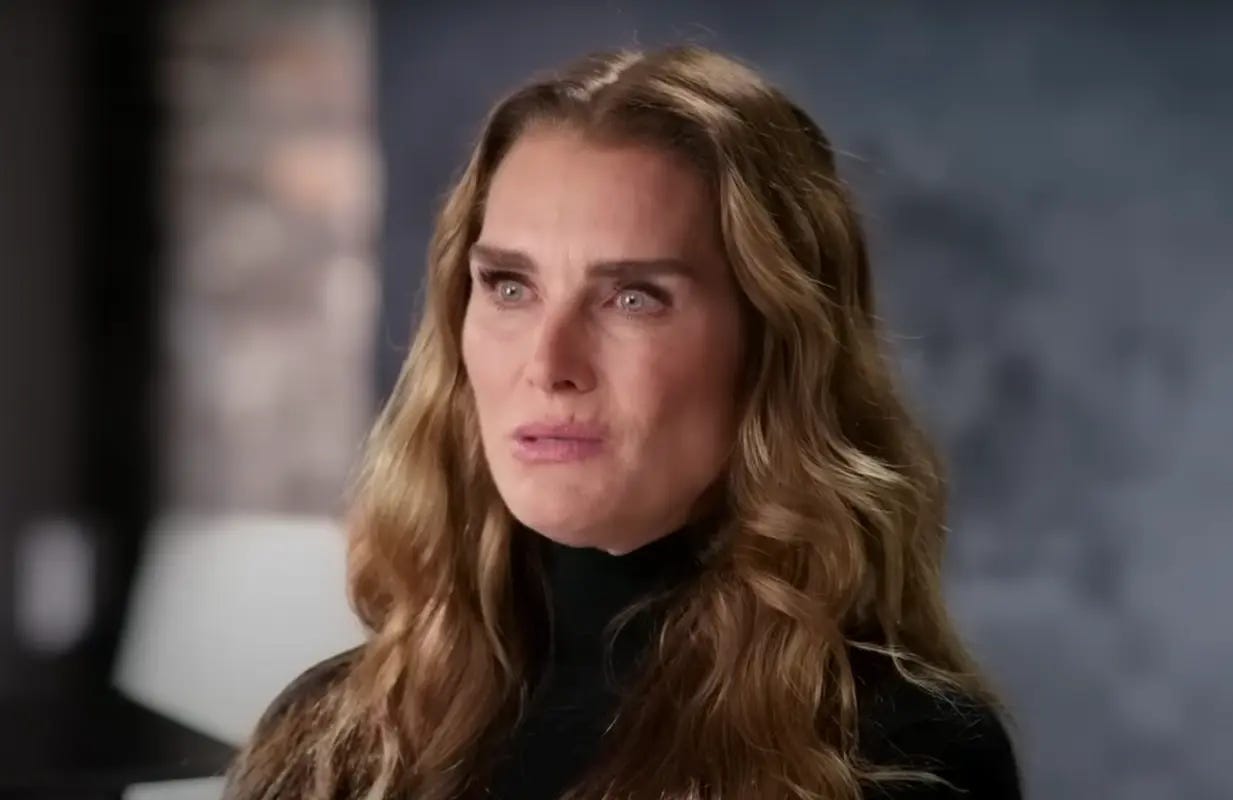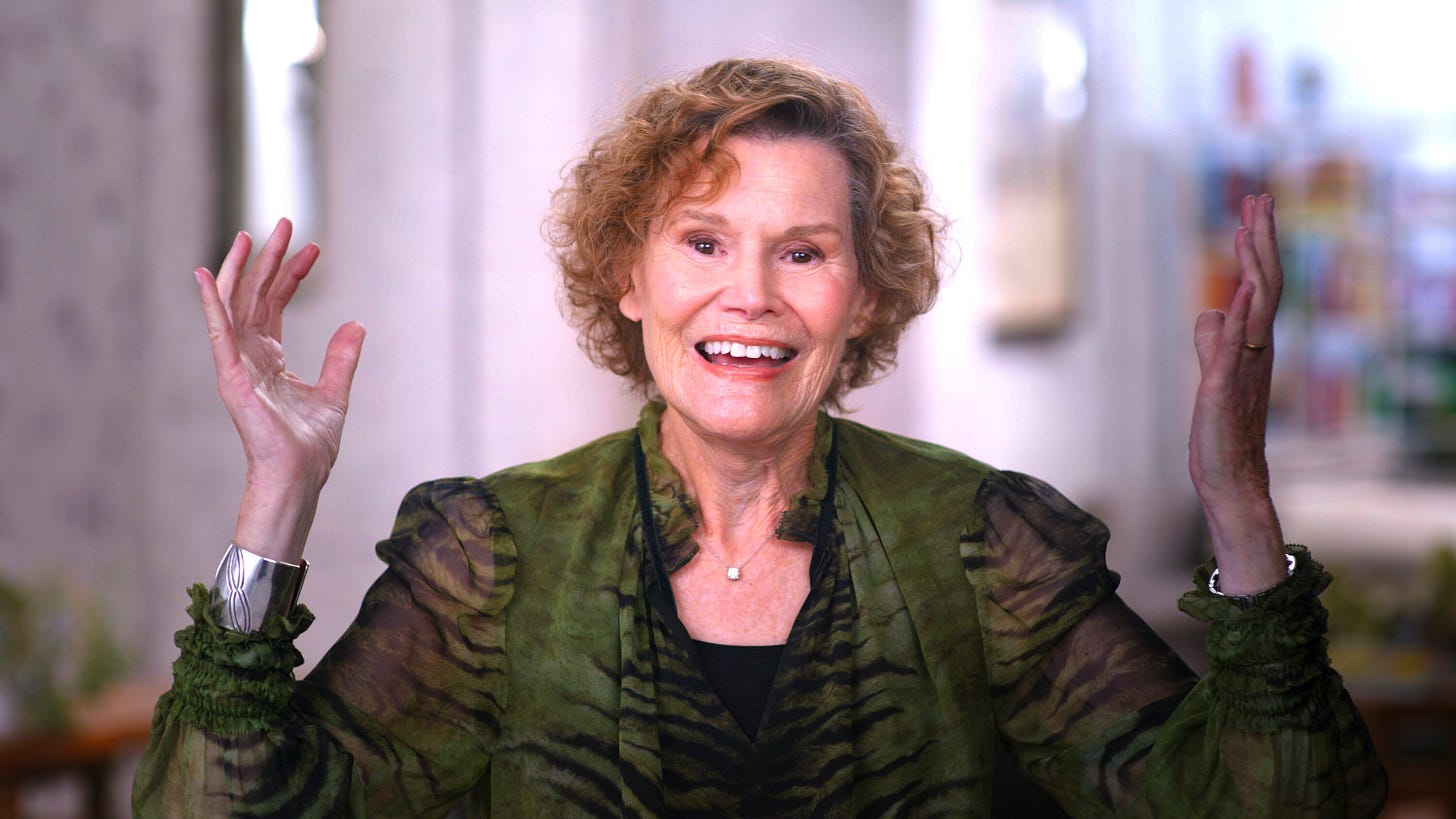Bio-Doc-O-Rama!
An influx of documentaries about Brooke Shields, Judy Blume, Michael J. Fox and Little Richard offer a chance to reflect on the possibilities and limitations of the form.
Biographical documentaries are a natural for the streaming era, when you can browse through a subscription service and click on whatever public figure you want to learn more about. It’s like the adult version of the popular “Who Was?” books for children, that paperback series with the boardwalk-style caricatures on the cover. In the words of Kendall Roy on Succession, they are “high-calorie info snacks.” Within the past month or two alone, four acclaimed new bio-docs have been released, three of them straight to streaming services—Pretty Baby: Brooke Shields (Hulu), Judy Blume Forever (Prime Video), and Still: A Michael J. Fox Movie (Apple TV+ on Friday)—and another, Little Richard: I Am Everything, that made its way to rental outlets only a couple of weeks after debuting in theaters.
I watched all four of them this week and they all pass the most basic test: If you’re interested in learning more about Brooke Shields, Judy Blume, Michael J. Fox, and Little Richard, then by all means pop these high-calorie info snacks in your mouth. But as I was burning through them, I kept thinking about an aesthetic standard that my friend (and Reveal reader) Mike D’Angelo has about documentaries, which boils down to this question: Could this film have just as easily been a magazine profile? Allowing that not all bio-docs can be as intimate as Terry Zwigoff’s Crumb or as form-expanding as archive-constructed portraiture of Asif Kapadia’s Senna, Amy, and Diego Maradona, I think that’s a fair concern. We should want movies to give us an experience that we could never have in any other medium.
With that in mind, here’s a round-up of our spring flowering of bio-docs:
Pretty Baby: Brooke Shields (dir. Lana Wilson)
Premise: Over this two-part, 138-minute documentary, the actress and model reflects candidly on decades in show business, from her experiences as a sexualized young star to her complicated relationship with her mother/manager to an unreported incident of sexual assault.
Memorable nugget: Though her characters in adolescent romances like The Blue Lagoon and Endless Love have sex, Shields herself was a virgin at the time—a fact she famously made public in 1985, much to her eventual regret. So for the sex scenes in Endless Love, director Franco Zeffirelli grabbed her toe and twisted it in order to get a look of “ecstasy” on her face.
Does it pass The D’Angelo Test?: No. Aside from one exceedingly stilted scene of Shields having a topical dinner conversation with her husband and two daughters, this is mostly a chronological rundown of Shields’ life and career, with the subject herself handling most of the talking-head duties.
Thoughts: Though director Wilson co-directed the crushing documentary After Tiller, Pretty Baby is more in line with Wilson’s last film, the solid Taylor Swift doc Miss Americana, in that it’s concerned with the impact of misogyny and tabloid scrutiny on female superstars and determined to allow them to tell their own story. That Swift Inc. is still fully operational gives Miss Americana an edge, especially in scenes where Wilson peers in on her artistic process, but Pretty Baby has a broader scope and great insight into how the culture that made Shields an iconic beauty also inflicted its share of harm.
Now in her mid-50s, Shields has not just survived a turbulent personal and professional life, but her memories are colored by the healthy perspective of someone who has learned from tough experiences. The two-part structure does make Pretty Baby feel as much like a television docu-series as it does a movie, but the parts do cover distinct stages in her life. The first part focuses on her time as a child model and young star for directors like Louis Malle, Randal Kleiser, and Zefferelli, her years as a Princeton student, and her close, at-times toxic relationship with a mother/manager given to the bottle. You’d assume her exploitation as an underage sex symbol would be the most disturbing section of her life, but second part gets into much darker terrain, including an unreported incident of sexual assault and her struggles with postpartum depression, which prompted an unfortunate rebuke from Tom Cruise. Pretty Baby is a reminder of Shields’ incredible fame and ubiquity, and a good prism into American popular culture and its alternately puritanical and leering attitudes about female sexuality.
Judy Blume Forever (dir. Davina Pardo, Leah Wolchok)
Premise: A career-spanning look at the popular and influential novelist whose frank yet sensitive portraits of adolescence in books like Are You There God? It’s Me, Margaret and Forever appealed to young readers while stoking controversy in conservative circles.
Memorable nugget: Blume agreed to appear to Crossfire without knowing who Pat Buchanan was. After Buchanan bombarded her with criticism based on out-of-context bits of Margaret and Deenie, the unflappable Blume got fed up and asked him, “Are you hung up about masturbation?”
Does it pass The D’Angelo Test?: No. This is mostly Blume herself, now blissfully retired and running a bookstore in Key West, reflecting on her life and career, with talking-head support from authors, artists, readers, and other fans of her work.
Thoughts: There’s nothing special about Judy Blume Forever as a piece of documentary craftsmanship, but Blume is such a thoughtful, positive, infectious presence that it’s nonetheless a pleasure (and sometimes tear-jerking) to spend time in her company. In fact, the film could lose all of the other interviewees without missing much of anything, save perhaps for the readers who wrote to Blume as children and were surprised to get a letter in return. (She even turned up to a college graduation on request.)
Blume’s professed ability to remember her own childhood in detail surely informed her work, and the film does well in connecting the people and events in her life to those in her books. More inspiring still is her simple mission to be honest about the experiences young people have, without worrying about the tacit restrictions that keep topics like menstruation from reaching school libraries. She would even do it matter-of-factly: Deenie is known as her “masturbation” book, but that’s only a passing detail in a coming-of-age tale about a 13-year-old with scoliosis who has to wear a body brace. For all the Moral Majority hullabaloo about her work, Blume’s candor as a writer (and as a person) is refreshingly casual and open, and often very funny. Forever may have shocked readers for its depiction of teenage sexuality, but how can you not smile about a boy who nicknames his penis “Ralph”?
Still: A Michael J. Fox Movie (dir. Davis Guggenheim)
Premise: Now over three decades into his fight with Parkinson’s disease, the Canadian star who catapulted to fame with Family Ties and Back to the Future reflects on his past and present, as he tries to manage his steadily worsening condition.
Memorable nugget: Fox recalls “coming close” to getting a role in Ordinary People, but knew he didn’t get the part when director Robert Redford spent the audition flossing his teeth.
Does it pass The D’Angelo Test?: Yes. Guggenheim deploys quite a few cinematic effects, like reenactments, to bring Fox’s personal and professional history to life. And as the only and one talking head, Fox opens up a window into his day-to-day struggles that’s visceral in a way that could never have the same impact on the page.
Thoughts: I haven’t much liked Guggenheim’s documentaries in the past, which tend to be overly slick and hagiographic—An Inconvenient Truth, It Might Get Loud, Waiting for ‘Superman,’ and The Road We Traveled are a few of the titles—but his energized treatment of Fox’s trajectory as an actor and human being supports what is otherwise a simple, effective one-man show. Fox has some great stories about coming up as a young actor in Hollywood, where his youthfulness and diminutive height allowed him to play boyish high-schoolers while in his early 20s. He talks about shooting Family Ties and Back to the Future simultaneously, which involves various Teamster drivers ferrying him around and propping him up on 20-hour work days.
But the most compelling sections of the film concern Fox’s efforts to mask his Parkinson’s for as long as possible, particularly the tremors in his left hand, which he’d suppress through crushed-up pills that he’d keep in his pocket. His constant activity—a feature of his life even before the disease, and the inspiration for the title—continues to keep him going, despite balance problems that have resulted in common falls and several broken bones. Though Guggenheim has made an admiring portrait overall, Fox is ruthlessly self-deprecating and candid about the mistakes that he’s made in his life. He’s not an inspirational mascot. He’s human.
Little Richard: I Am Everything (dir. Lisa Cortes)
Premise: Through extensive archival materials and a number of notable interview subjects, including Mick Jagger and John Waters, Cortes’ documentary makes the case for Little Richard, the “architect of rock and roll,” as its true king. Even Elvis says so.
Memorable nugget: Though many future rock icons were influenced by Little Richard, no one matches Mick Jagger, who was so mesmerized by his stage presence that he saw him in concert at least 30 times.
Does it pass The D’Angelo Test?: Barely. The approach here is standard-issue for the biography of a person who’s no longer living: Talking heads plus archival footage. Yet the performance footage is sensational and critical for the argument the film is trying to make about Little Richard’s legacy.
Thoughts: What a life! Though the talking heads are mostly well-chosen—John Waters is gold any time you put him in front of a camera—I Am Everything might have worked even better as an Asif Kapadia-style construction through archival footage. Or at least a documentary that leans far less on outside voices for context. There’s plenty of footage of Little Richard speaking for himself, in all his flamboyance and contradiction, and the clips of him on stage, sweating and gyrating and lighting the room on fire, speak to the unique electricity he was able to generate. (It’s a true miracle that he lived to 87, given his excesses and provocations.)
Though his public life swerved into unfortunate territory, driven by a fear that the carnality he expressed so vigorously on stage and off would lead to eternal damnation, I Am Everything restores Little Richard’s legacy as perhaps the central figure in rock and roll, connecting the dots between him and The Beatles, The Rolling Stones, Elvis, David Bowie, Prince, and the innumerable other greats that followed his lead. It also gets into the sticky issue of appropriation, posing the question of when the inspiration of Black artists like Little Richard edges into “obliteration.”









It funny, "this is magazine article" pretty common critique in book publishing too. But me will very happily make case that writing article about Little Richard is like trying to describe what cookie taste like by drawing stick figure. You have to be able to hear music, and you have to be able to see his energy on stage.
And he was absolutely central figure in rock and roll. He, Elvis, and Chuck Berry all started recording basically simultaneously, but if you need origin story for rock and roll, this is that story:
In 1955, struggling gospel singer had been dropped from record label for failing to produce follow-up to his one minor hit. He had been thrown out of his parents' house for being gay. He had no money, no support, was working as dishwasher and doing sleazy nightclub act to pay rent. He had auditioned for several new record labels and been turned down. He was down to last name on list, Specialty Records, best known for Fats Domino.
Richard auditioned playing alongside Domino's backup band. He played some gospel numbers, and he knew label heads not were going for it. He was blowing his last chance. So with nothing to lose, he pulled out up-tempo number from his nightclub act. It was very explicit song about gay sex, but it had lot of energy and he thought it might get label excited. But band was used to playing Fats Domino's stately melodies, and they had trouble with this fast song and energetic singer. In particular, drummer not could get drum intro right. He tried again and again, until a frustrated Richard shouted it at him: A wop bop a loo bop, a wop bam boom!
And that, friends, is moment rock and roll came into being.
A little misdirection in the opening paragraphs! By the end, you had made me want to snack on all four of these, but especially Still.